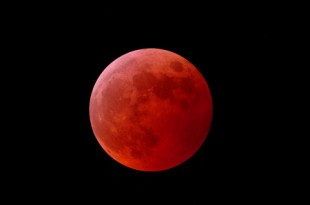View Sept. 27 lunar eclipse at Rice Campus Observatory
Weather permitting, the Rice University Campus Observatory will host a free open house 8-10 p.m. Sept. 27 for viewing a rare lunar eclipse that will coincide with the closest and largest full moon of 2015.
Total lunar eclipses occur when the moon passes through Earth’s shadow and are best viewed on cloudless evenings. While they are not rare — on average there is one total lunar eclipse per year — they are striking events because the moon appears reddish, a feature sometimes referred to as a “blood moon.”
On Sept. 27, the moon will begin entering Earth’s shadow at 8:07 p.m., and the total phase of the eclipse will last from 9:11 to 10:23 p.m.
The eclipse will occur when the moon is at perigee, the point in the moon’s orbit when it is closest to Earth. Perigee full moons appear slightly larger in the sky than a typical full moon, and although the difference is difficult to ascertain with the naked eye, perigee full moons are sometimes referred to as “supermoons.”
Rice astronomer Patrick Hartigan, who wrote about the eclipse on his blog, said the next time a perigee full moon will coincide with a total lunar eclipse in Houston will be Oct. 8, 2033.
“The best part about this eclipse is that it occurs at a very convenient time that should make for pleasant viewing for most people,” said Hartigan, professor of physics and astronomy.
He said people who cannot come to the observatory can still enjoy the eclipse.
“Lunar eclipses are slow-evolving events that require no equipment to observe,” Hartigan said. “Provided we have no clouds, this should be a perfect evening for sitting out in a lawn chair and observing one of nature’s true wonders. If you have a pair of binoculars, that’s even better.”
Anyone planning to attend the open house is encouraged to check for weather updates and potential cancellations at the following websites before heading to campus:
http://events.rice.edu/index.cfm?EventRecord=26773
http://www.ruf.rice.edu/~ruco/open_houses.html
The Rice campus observatory is located on the fourth floor of Brockman Hall for Physics. Observatory officials suggest that off-campus visitors use Entrance 21 on Rice Boulevard and park in the North Parking Lot.
For directions and other details, visit the observatory home page at http://www.ruf.rice.edu/~ruco/observatory.html.



Leave a Reply